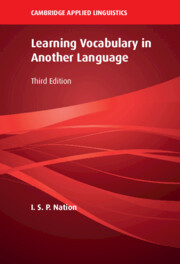Book contents
- Learning Vocabulary in Another Language
- The Cambridge Applied Linguistics Series
- Learning Vocabulary in Another Language
- Copyright page
- Contents
- List of figures
- List of tables
- Acknowledgements
- Introduction
- 1 The goals of vocabulary learning
- 2 Knowing a word
- 3 Teaching vocabulary and the roles of the teacher
- 4 Vocabulary and listening and speaking
- 5 Vocabulary and reading and writing
- 6 Learning vocabulary out of class
- 7 Vocabulary in specialised areas
- 8 Vocabulary-learning strategies and autonomy
- 9 Learning words from context
- 10 Word parts
- 11 Deliberate vocabulary learning from word cards
- 12 Finding and learning multiword units
- 13 Testing vocabulary knowledge and use
- 14 Designing the vocabulary component of a language course
- Book part
- References
- Author index
- Subject index
6 - Learning vocabulary out of class
Published online by Cambridge University Press: 02 June 2022
- Learning Vocabulary in Another Language
- The Cambridge Applied Linguistics Series
- Learning Vocabulary in Another Language
- Copyright page
- Contents
- List of figures
- List of tables
- Acknowledgements
- Introduction
- 1 The goals of vocabulary learning
- 2 Knowing a word
- 3 Teaching vocabulary and the roles of the teacher
- 4 Vocabulary and listening and speaking
- 5 Vocabulary and reading and writing
- 6 Learning vocabulary out of class
- 7 Vocabulary in specialised areas
- 8 Vocabulary-learning strategies and autonomy
- 9 Learning words from context
- 10 Word parts
- 11 Deliberate vocabulary learning from word cards
- 12 Finding and learning multiword units
- 13 Testing vocabulary knowledge and use
- 14 Designing the vocabulary component of a language course
- Book part
- References
- Author index
- Subject index
Summary
This chapter covers three situations of vocabulary learning, all of which can occur outside the classroom. The first situation has been called extramural English or extramural learning, and could be called learning through entertainment. It involves largely incidental learning through watching TV or movies, surfing the Internet, online social interaction, playing online games, listening to songs, or reading or listening for pleasure. It can also include social interactions with native speakers. Extramural learning is not a part of a regular English course and is not under the control of a classroom teacher. The second situation is supplementary learning. This involves learning outside the classroom which is related to a course occurring inside the classroom. It is largely directed by the classroom teacher. It may involve extensive reading, extensive listening, interacting with others, and writing, and could also involve the deliberate learning of vocabulary and other language features. The third situation has been called self-directed learning and involves the learner organising their own language course without the help of a teacher.
Keywords
- Type
- Chapter
- Information
- Learning Vocabulary in Another Language , pp. 242 - 274Publisher: Cambridge University PressPrint publication year: 2022



